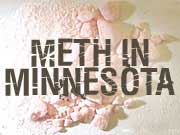|
Photos
Resources
Your Voice
|
Meth poses a danger to first responders
June 11, 2004
 |
| A recent training session for law enforcement officials on decontamination after exposure to chemicals in a meth lab. The dangers posed by those chemicals mean first responders, law enforcement and hospital workers must learn new techniques to protect themselves from exposure. (MPR Photo/Tim Post) |
Douglas County, Minn. — Greg Windhurst has seen his share of drug busts. The 38-year old drug agent works with the West Central Drug Task Force in Douglas County, and has spent 14 years working with the Douglas County Sheriff's Department.
Windhurst says meth presents new problems not only for cops, but ambulance crews and emergency room workers. The danger comes from the caustic chemicals used to make meth -- such as anhydrous ammonia, sulfuric acid, acetone, and lye -- which can sicken those who come in contact with them.
He warns first responders to beware of houses with meth labs. Windhurst knows it's their job to charge into dangerous situations and save people. But if there's a meth lab in a house, Windhurst tells first responders to stay out, even if the people inside are in danger.
 | |||
"If there is a meth lab, don't go in. Who cares about the people inside. Until you're adequately protected, don't go in there," Windhurst says.
That's the same advice the Minnesota Department of Health offers.
Deborah Durkin, who's in charge of the department's meth program, says if first responders get hurt in a meth lab, they can't do their jobs.
Durkin says only first responders trained to deal with a meth lab should enter. They should be dressed in chemical suits and use respirators or oxygen tanks.
Anyone who lives in a house with a meth lab needs to be taken to a hospital immediately. That means hospital workers could be exposed to any of the chemicals that have soaked into a meth maker's clothing.
Durkin suggest police and ambulance crews learn the basic points of decontamination.
"Absolutely anyone taken out of a meth lab should be stripped, hosed down and changed into different clothing before they're transported to a hospital or a jail," Durkin says.
Minnesota counties are taking a creative approach to getting the necessary equipment they need to decontaminate people taken from meth labs.
"Several Minnesota counties are using federal dollars for bioterrorism to buy decontamination tents," Durkin says. "They're easily transportable, they have a heater attached to provide warm water. And unlike stripping someone down in the front yard and hosing them off, it provides some privacy."
Durkin says that's the best way for emergency personnel to handle the problem of meth contamination. She says meth labs are the closest thing to terrorism most rural Minnesota counties will ever face.
|
News Headlines
|
Related Subjects
|

